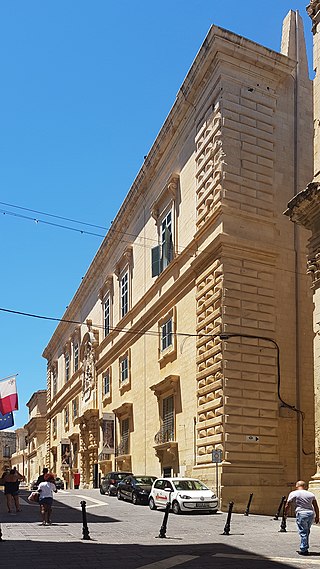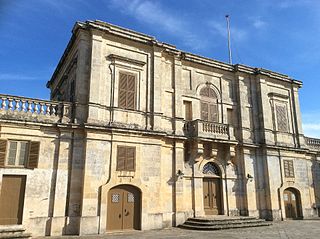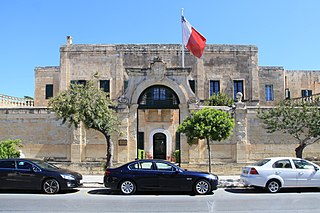
Comino is a small island of the Maltese archipelago between the islands of Malta and Gozo in the Mediterranean Sea, measuring 3.5 square kilometres (1.4 sq mi) in area. Named after the cumin seed, the island has a permanent population of only two residents and is part of the municipality of Għajnsielem, in southeastern Gozo, from where one priest and one policeman commute. The island is a bird sanctuary and nature reserve.

The Citadel, also known as the Castello, is the citadel of Victoria on the island of Gozo, Malta. The area has been inhabited since the Bronze Age, and the site now occupied by the Cittadella is believed to have been the acropolis of the Punic-Roman city of Gaulos or Glauconis Civitas.

St Francis of Assisi Church, dedicated to St Francis of Assisi, in Valletta, was built in 1598 and was completed by 1607.

The Metropolitan Cathedral of Saint Paul, commonly known as St Paul's Cathedral or the Mdina Cathedral, is a Catholic cathedral in Mdina, Malta, dedicated to St. Paul the Apostle. The cathedral was founded in the 12th century, and according to tradition it stands on the site where Roman governor Publius met St. Paul following his shipwreck on Malta. The original cathedral was severely damaged in the 1693 Sicily earthquake, so it was dismantled and rebuilt in the Baroque style to a design of the Maltese architect Lorenzo Gafà between 1696 and 1705. The cathedral is regarded as Gafà's masterpiece.

The Auberge de Castille, historically in full known as the Auberge de Castille et Portugal, is an auberge in Valletta, Malta. The auberge is located at Castile Place, close to Saint James Cavalier, the Malta Stock Exchange, and the Upper Barrakka Gardens. It sits at the highest point of Valletta and overlooks Floriana and the Grand Harbour area.

The Gozo Museum of Archaeology is a museum in the Cittadella, the oldest part of the city, of Victoria in Gozo, Malta. The museum of Archaeology was opened in 1960 as the first public museum in Gozo and was known as the Gozo Museum. The museum was redesigned and reopened in 1986 as the Archaeology Museum of Gozo. Today it is known as the Gozo Museum of Archaeology or the National Museum of Archaeology. The museum features archaeological artifacts and relics and displays covering the cultural history of the Island of Gozo from the prehistoric era to the early modern period. Its exhibits include the Maymūnah Stone.

Saint Mary's Tower, also known as the Comino Tower, is a large bastioned watchtower on the island of Comino in Malta. It was built in 1618, the fifth of six Wignacourt towers. The tower was used by the Armed Forces of Malta until 2002, and it is now in the hands of Din l-Art Ħelwa.

The Auberge de Bavière is a palace in Valletta, Malta. It was built as Palazzo Carneiro in 1696, and was the residence of Grand Master Marc'Antonio Zondadari in the early 18th century. In 1784, it was converted into the auberge for the Anglo-Bavarian langue of the Order of Saint John, and remained so until the French occupation of Malta in 1798.

The Auberge d'Italie is an auberge in Valletta, Malta. It was built at various stages in the late 16th century to house knights of the Order of Saint John from the langue of Italy, and it originally had a Mannerist design by Girolamo Cassar and several other architects. The building continued to be modified throughout the course of the 17th century, with the last major renovation being carried out in the 1680s during the magistracy of Gregorio Carafa, giving the building a Baroque character.

Ferretti Battery, also known as Qajjenza Battery or Saint George's Battery, is an artillery battery in the village of Qajjenza, within the limits of Birżebbuġa, in Malta. It was built by the Order of Saint John in 1715 and 1716 as one of a series of fortifications around the coasts of the Maltese Islands. A restaurant exists within the walls of the battery, serving Mediterranean cuisine.

The National Inventory of the Cultural Property of the Maltese Islands (NICPMI) is a heritage register listing the cultural property of Malta. The inventory includes properties such as archaeological sites, fortifications, religious buildings, monuments and other buildings. The NICPMI is under the responsibility of the Superintendence for Cultural Heritage (SCH), which was founded in 2002 to replace the Antiquities Act. The NICPMI was established on 16 December 2011.

Palazzo Parisio, sometimes known as Casa Parisio, is a palace in Valletta, Malta. It was built in the 1740s by Domenico Sceberras, and eventually passed into the hands of the Muscati and Parisio Muscati families. It was Napoleon's residence for six days in June 1798, during the early days of the French occupation of Malta. The palace was eventually acquired by the de Piro family, and was later purchased by the Government of Malta. It was used as the General Post Office from 1886 to 1973, then the Ministry for Agriculture, and it now houses the Ministry for Foreign Affairs.

Palazzo Parisio, formerly known as Scicluna Palace, Palazzo Scicluna, and officially Palazzo Parisio and Gardens, is a 20th-century palace in Naxxar, Malta. On site was a hunting lodge built in 1733 by Paolo Parisio, and was used as a summer or permanent residence, barracks and a college, before being acquired by the Marquis Scicluna in 1898.

Dragonara Palace, also known as Palazzo Dragonara or Villa Dragonara, is a palace in St. Julian's, Malta. It was built in 1870 as a summer residence for the Scicluna family, and it is now a casino called Dragonara Casino.

The Banca Giuratale, formerly also known as Banca dei Giurati, the Municipal Palace, the Palazzo della Città, Casa Città and the Consolato del Mare, is a public building in Valletta, Malta. It was built in the 18th century to house the city's administrative council, and it was subsequently used as the General Post Office and the Public Registry. The Banca Giuratale now houses the Ministry for the Economy,Enterprise and Strategic Projects, and it is officially known as Palazzo Zondadari.

Palazzo Dorell also known as Bettina Palace, is a 17th-century Palladian palace located in Gudja, Malta.

Casa Leoni or Casa Leone, also known as Palazzo Manoel or the Vilhena Palace, is a palace in Santa Venera, Malta, which was built as a summer residence for Grand Master António Manoel de Vilhena in 1730. It was subsequently used for a number of purposes, including as an insurgent command base, an official residence, a museum depository and a school. It currently houses the Ministry for Transport, Infrastructure and Capital Projects (MTIP).

The Corte Capitanale is a former courthouse in Mdina, Malta, which currently serves as a city hall. It was built in the Baroque style between 1726 and 1728, to designs of the French architect Charles François de Mondion. The building is linked to Palazzo Vilhena, but it has its own entrance and façade.

Palazzo Santa Sofia is a palace in Mdina, Malta, located in Villegaignon Street, across the square from the cathedral. Its ground floor was built in 1233, and it is believed to be the oldest surviving building in the city. The upper floor is of a much later construction, being built in the 20th century.

The Hostel de Verdelin, also known as Palazzo Verdelin or the Casa delle Colombe, is a palace in Valletta, Malta. It was built in the mid-17th century for the knight Jean-Jacques de Verdelin, and it is an early example of Baroque architecture in Malta. The palace currently houses a police station and a restaurant.






















